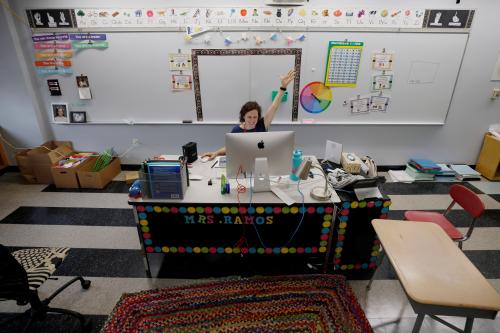Tom Loveless’s new book, “Between the State and the Schoolhouse: Understanding the Failure of Common Core,” is out April 2021 through Harvard Education Press. The book’s introduction is available to read online here.
More than a decade after the 2010 release of Common Core State Standards in English language arts and mathematics, no convincing evidence exists that the standards had a significant, positive impact on student achievement. My new book—“Between the State and the Schoolhouse: Understanding the Failure of Common Core”—explores Common Core from the initiative’s promising beginnings to its disappointing outcomes.
While the book is specifically about Common Core, the failure of that bold initiative can only be understood in the context of standards-based reform, of which Common Core is the latest and most famous example. For three decades, standards-based reform has ruled as the policy of choice for education reformers.
The Theory of Standards-Based Reform
The theory of standards-based reform rests on the belief that ambitious standards in academic subjects should be written first, guiding the later development of other key components of education—curriculum, instruction, assessment, and accountability. By promoting a common set of outcomes, standards-based reformers argue, the fragmentation and incoherence plaguing previous reform efforts could be avoided.
The approach is inherently top-down and regulatory, with standards developed by policy elites and content experts at the top of the system. The other components, all of which are bolted to the academic standards, grow in importance downstream and are often under the control of practitioners. The book focuses on curriculum and instruction, the what and the how of learning. They are key to the production of learning in classrooms.
Despite the theory’s intuitive appeal, standards-based reform does not work very well in reality. One key reason is that coordinating key aspects of education at the top of the system hamstrings discretion at the bottom. The illusion of a coherent, well-coordinated system is gained at the expense of teachers’ flexibility in tailoring instruction to serve their students. Classrooms are teeming with variation. An assumption of Common Core advocates is that variation in learning occurs primarily because of schools and classrooms possessing disparate, and all too often, indefensibly low standards—that if schools were brought under a common regime of high expectations, children who are falling behind would catch up or never fall behind in the first place.
High Expectations Are Not Enough
That basic notion is wrong. Simply having higher expectations is not enough to drive systemic improvement downstream. One of the most highly replicated findings of education research is that a good predictor of how much students will learn tomorrow is how much they know today. Studies of interventions that simply ratchet up expectations without regard for students’ prior knowledge have yielded disappointing results. The “algebra for all” policies of the 1990s and early 2000s placed many unprepared eighth graders in Algebra I courses. They not only failed to learn algebra and fell further behind their peers, but many subsequently took a series of advanced math courses that doomed their high school math careers to repeated failure.
Low standards do not create such disparities. Data from NWEA assessments show that the reading abilities of students entering kindergarten cover about a five-year span, from that of a typical three-year-old to that of a typical eight-year-old (based on the 90th-10th percentile gap). Previous years’ slack standards or inept teaching cannot affect the learning of youngsters entering school for the first time. The federal government’s Early Childhood Longitudinal Study, a massive study that began with kindergartners in 1998-99 and followed them through eighth grade, found a comparable span of achievement among kids just starting school. The gaps associated with family socioeconomic status (SES) were enormous. As reported in “Inequality at the Starting Gate,” test scores of students in the top and bottom SES quintiles differed by 1.24 standard deviations in math and 1.17 standard deviations in reading.
Standards as Written, Standards as Implemented
Another flaw in the theory is that no one knows what standards as written will look like when they are ultimately implemented. Standards must pass through many organizational layers—from state to district to school to classroom—before coming in contact with students. Each transition allows reinterpretation to fit educators’ beliefs about how reading and math should be taught. Bill Honig, California’s state superintendent of public instruction in the 1980s, oversaw the crafting of the state’s 1987 English language arts framework (that era’s term for standards). The document did not mention whole language reading instruction, but true believers in that approach put their stamp on the state’s policies during implementation. Years later, Honig would charge, “The framework was hijacked by the whole language movement.”
Common Core’s authors tried to forge a compromise between contrasting reading philosophies, emphasizing the importance of both sound-symbol, code-based instruction and more holistic, comprehension focused strategies. Louisa Moats, co-author of the foundational reading skills section of Common Core, described the English language arts standards as “a political and philosophical compromise.” After observing a few years of implementation, Moats concluded that “systematic, cumulative skill development and code emphasis instruction is getting short shrift all around.”
Moats is not the only observer to draw this conclusion. In 2019, Emily Hanford of APM Reports ran a series on classroom instruction with nascent readers and documented widespread use of disproven practices; for example, guessing at a word based on a picture rather than sounding out the word. That same year, a survey conducted by Education Week found that the top five programs used in K-2 literacy instruction frequently “diverge from evidence-based practices for teaching reading or supporting struggling students.” Note that both reports were published nine years after the adoption of Common Core.
Political Cover
Officials may also use standards for political cover so that they can adopt unpopular policies. Math reformers have long dreamed of U.S. schools abandoning the traditional high school math sequence that is organized by math domains (beginning with an Algebra I course and ending with calculus or pre-calculus), preferring instead integrated math courses (Math 1, Math 2, etc.) that combine algebra, geometry, statistics, and other math topics into a single course. Common Core provided guidance for either approach, implying equivalence, despite approximately 95% of high schoolers enrolled in the traditional sequence. Utah, North Carolina, and West Virginia switched to integrated math as Common Core was rolled out. The state of Georgia had pushed for an integrated math sequence since 2008, but several local districts resisted, and they were given the option of continuing the traditional sequence. After implementing Common Core, the state eliminated that option. As the popularity of Common Core declined, support for integrated math fell as well. A 2014 survey of Georgia’s math teachers revealed 84% supporting the traditional math sequence, driving the final nail in the coffin for integrated math.
Are Educators Simply Reluctant to Change?
Do not allow the integrated math experience in Georgia to persuade you that Common Core failed because teachers refused to change old habits or did not receive enough training on the standards. A lot of money was spent on professional development supporting Common Core, and teachers, in fact, did change some aspects of instruction. Surveys indicate that, compared to pre-Common Core instruction, teachers now place greater stress on reading nonfiction or informational texts over the study of fiction, expository writing assignments requiring the use of evidence over imaginary stories or first-person accounts, and gaining conceptual understanding and learning applications in math over mastering procedures. All of these changes are in accord with Common Core. The real problem is that the research evidence that these reforms boost reading or math achievement is spotty at best.
Recent trends in the educator workforce also suggest that resistance was not a major factor in determining Common Core’s fate. At the same time that Common Core was adopted and implemented, a mass exodus of baby boomers from the teaching profession was taking place. (In fact, in the next few years, teachers who have worked under no other standards but Common Core will outnumber those who taught under different standards.) The unwillingness of teachers to change is not the problem.
The Future
What now? The pandemic has placed debates over standards and other education policies on hold. Attention is focused on safely getting schools reopened and teachers and kids back into classrooms. Standards-based reform is a regulatory approach to school improvement. A new approach is needed once this crisis ends, emphasizing the improvement of curriculum and instruction—the technical core of schooling—through careful experimentation and the development of new materials and methods.
The history of modern medicine illustrates the revolutionary impact that scientific advancements can have on an entire field of knowledge. In 1900, the life expectancy of a child born in the U.S. was about 50 years. For a child born in 2000, life expectancy is 80 years. Although regulation of the medical profession has increased a lot since 1900, it’s difficult to imagine the quality of today’s life without the countless discoveries of 20th-century medicine, producing effective new tools for treating the sick, and in some cases, completely eradicating diseases that had plagued human beings for centuries.
Replacing Common Core with a different set of standards will solve very little. The United States cannot regulate its way to educational excellence. It’s time to invest resources in improving the basic science of education—including the discovery of new, effective instructional strategies and curricula that boost learning. Scientific discovery, not standards-based regulation, should be the dominant theme of the next era of education reform.






Commentary
Why Common Core failed
March 18, 2021